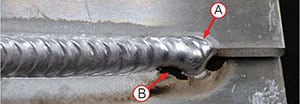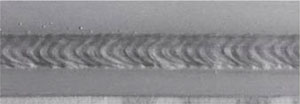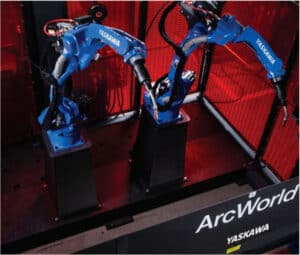ADVANTAGES OF ROBOTIC WELDING SYSTEMS
COMBAT THE SHORTAGE OF SKILLED WELDERS
It is becoming harder and harder for many companies to fill their open welding positions. The American Welding Society projects that by 2023, there will be a shortage of over 375,000 welders in the U.S. which is a major problem for many companies. For companies who are able to find welders to hire, it is difficult to train and retain them. Robotic welding systems help overcome these issues and provide an immediate solution.
CONSISTENT, HIGH-QUALITY WELDS
Manual welding takes a great deal of skill and concentration to consistently produce quality welds. Even the best welders make mistakes from time to time. Robotic welding systems offer an extremely high degree of repeatability and precision. Over and over, they can place a high-quality weld in the same spot without losing concentration or making a wrong movement.
PRODUCTS
PRODUCTS
MANUFACTURERS
AUTOMATION SOLUTIONS
INFO CENTER
ABOUT US
SCHEDULE A
DEMO


HIGHER PRODUCTIVITY & THROUGHPUT
Welding is a tough and hazardous occupation. Welding workers are exposed to a number of risks, including toxic gases and fumes, flash burns, electric shocks, and more. Robotic welding systems can endure these hazards and protect human workers from being exposed to them. Additionally, this can prevent or considerably reduce accident and insurance related costs for the company.
REDUCED COSTS
In analyzing the investment for a robotic cell, it is important to consider the Total Cost of Ownership over the long-term (7+ years) as robotic systems last a long time and the cost-savings can be significant. Considering the most significant savings come from manual welding direct labor, this strengthens the return on investment for robotic systems. Additionally, robotic welders conserve materials such as weld wire and only use the necessary amount. The cost of these materials adds up quickly over time and using them more economically can provide a great deal of cost-savings. Lastly, as we mentioned, robotic welders can prevent (or considerably reduce the potential for) significant accident and insurance related costs for manufacturing companies.
LESS WASTE
With robotic welding systems, everything is controlled and regulated which means they only use the necessary amount of energy and power. Additionally, with the consistency and quality that robotic welding systems provide, the amount of scrap is drastically reduced.
LEARN MORE ABOUT ROBOTIC WELDING SYSTEMS
Interested in learning more about robotic welding systems or wondering if one is the right fit for you? Mechatronic Solutions is a leading distributor of Yaskawa Motoman robotic welding systems and is here to answer any questions you might have. Just give us a call at (763) 447-3407 or fill in the Contact Us form to speak with one of our engineers!
